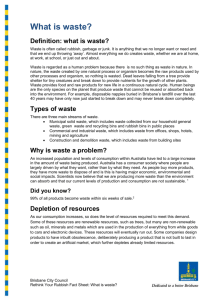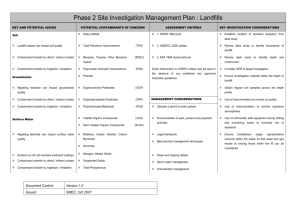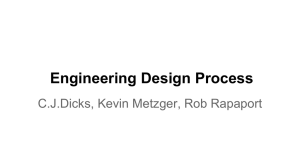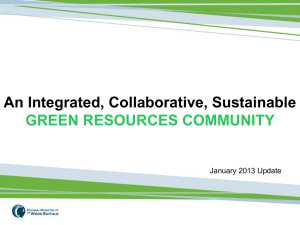Build a model landfill (Word - 356kb)
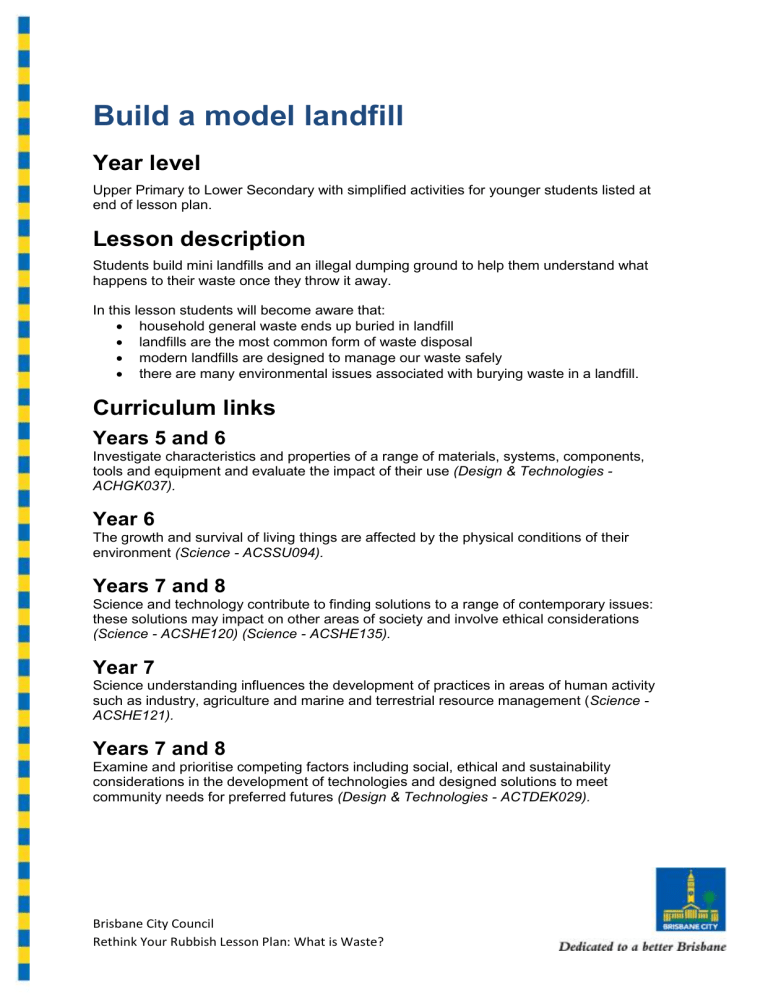
Build a model landfill
Year level
Upper Primary to Lower Secondary with simplified activities for younger students listed at end of lesson plan.
Lesson description
Students build mini landfills and an illegal dumping ground to help them understand what happens to their waste once they throw it away.
In this lesson students will become aware that:
household general waste ends up buried in landfill
landfills are the most common form of waste disposal
modern landfills are designed to manage our waste safely
there are many environmental issues associated with burying waste in a landfill.
Curriculum links
Years 5 and 6
Investigate characteristics and properties of a range of materials, systems, components, tools and equipment and evaluate the impact of their use (Design & Technologies -
ACHGK037).
Year 6
The growth and survival of living things are affected by the physical conditions of their environment (Science - ACSSU094).
Years 7 and 8
Science and technology contribute to finding solutions to a range of contemporary issues: these solutions may impact on other areas of society and involve ethical considerations
(Science - ACSHE120) (Science - ACSHE135).
Year 7
Science understanding influences the development of practices in areas of human activity such as industry, agriculture and marine and terrestrial resource management ( Science -
ACSHE121).
Years 7 and 8
Examine and prioritise competing factors including social, ethical and sustainability considerations in the development of technologies and designed solutions to meet community needs for preferred futures (Design & Technologies - ACTDEK029).
Brisbane City Council
Rethink Your Rubbish Lesson Plan: What is Waste?
Materials
Materials listed are for one lined, one unlined model landfill, and a model of an illegal dumping ground.
6 x two litre plastic soft drink bottles with labels removed
3 x blue dishwashing sponges cut into the round shape of the circumference of the soft drink bottles
2 x yellow dishwashing sponges cut into the round bottle shapes as above
plastic supermarket bag cut into the round shape of the circumference of the bottle
6 cups of soil
3 cups of small gravel e.g. aquarium gravel
red food colouring
water
fact sheets ‘Waste Collection’ and ‘Landfill’ available on Brisbane City Council website
Procedure
1. Before the start of the activity, cut off the bottom of three of the bottles (about ten centimetres from the base) and the top off the other two bottles (about ten centimetres from the top). See Figure 1 overleaf.
2. Discuss what happens to household waste in Brisbane after the general waste bin is collected by the garbage truck. Refer to fact sheets about ‘Waste collection’ and
’Landfill’ for more detailed information. Questions might include the following.
Where does the garbage truck take your rubbish?
o To transfer stations at Nudgee, Willawong, Chandler or Ferny Grove and from there to Rochedale Landfill.
What is a landfill? o A landfill is where our waste gets buried. Modern landfills are carefully engineered, constructed and managed in order to reduce their impact on the environment.
Why are modern landfills lined? o A typical modern landfill is lined with a layer of clay and protective plastic to prevent the liquid waste (leachate) from leaking into the ground or ground water. A network of drains collects the leachate and pumps it to the surface where it can be treated. Ground wells around the landfill are used to monitor the groundwater quality and detect any contamination.
What are some of the environmental issues associated with landfills? o Three most important issues are leachate, toxins and methane gas. o Leachate is the liquid that collects within a landfill as the waste breaks down.
It is smelly and toxic and can pollute the groundwater, waterways and the soil that it comes in contact with. o Toxins are hazardous substances such as mercury and lead which have come from the waste dumped in landfill and like leachate have the potential to poison the surrounding environment.
Brisbane City Council
Rethink Your Rubbish Lesson Plan: What is Waste?
Lined landfill
To make the lined landfill, place the top of ‘Bottle B’ upside down in the base of ‘Bottle A’ to use as a holder. Leave the lid of ‘Bottle B’ screwed on. Join together with clear tape. The bottom part of ‘Bottle B’ is not needed and can go in your recycling bin. If you wish you can tape the top of ‘Bottle A’ to the finished landfill once all the layers have been completed, but this is optional.
Add the following layers:
¾ of a cup of gravel in the bottom of ‘Bottle B’ – this represents the bedrock, gravel or impermeable clay which holds the groundwater.
A blue sponge on top of the gravel – this represents the groundwater
½ cup of soil – this represents the soil layer below the landfill lining
¼ cup of gravel – this thin layer of gravel represents the thick layer of clay which is placed below the liner to help prevent leachate entering the soil
Plastic bag liner cut so that it completely covers soil – this represents the thick plastic liner that prevents leachate from entering the soil and ground water layers
Yellow sponge on top of liner – this represents the rubbish. Rubbish would have been evenly spread and compacted before being buried. The red food colouring is added to represent leachate. When water is added it will be possible to see the leachate move into the soil and ground water
½ cup of soil – this represents the soil layer that covers the rubbish to prevent rubbish being blown away, to minimise odours and to deter scavengers and pests
A small number of paper scraps can be added to the top if you wish to indicate litter that may blow around before the rubbish is buried o Landfill gas is largely composed of carbon dioxide and methane gas. It is produced in landfill from the breakdown of organic waste. Methane gas is a very volatile greenhouse gas that is around 21 times more potent than carbon dioxide.
What measures are in place to try and reduce and control the environmental impact of burying waste in a landfill?
There are lots of environmental controls at the landfill including:
collection and treatment of groundwater;
monitoring of gas;
collection and treatment of leachate;
mobile litter screens to collect litter;
deodorisers to neutralise unpleasant smells;
collection, treatment and monitoring of stormwater run off
pest control.
dust suppression
vegetation management
3. Explain that in this activity they are going to build three different models of waste disposal: a modern lined landfill; an unlined landfill and an illegal rubbish dump.
The aim is to show the impact that rubbish can have on the soil, ground water and surrounding land/water if not properly managed.
Brisbane City Council
Rethink Your Rubbish Lesson Plan: What is Waste?
Unlined landfill
Follow the instructions above, but omitting the plastic bag liner and the thin layer of gravel above the rubbish layer. These layers are what prevent leachate seeping into the soil and groundwater in modern lined landfills.
Figure 1
Illegal rubbish dump (or tip)
Start the model in the same way with a layer of gravel, a blue sponge and a layer of soil.
Chop up the yellow sponge into small pieces to show that the rubbish hasn’t been compressed and add small bits of paper, plastic, twigs, metal (eg paper clips, battery) and small bits of food to represent the fact that the rubbish is just dumped on the ground and not covered.
4. Once the mini landfills are complete line them up side by side. Remove the caps of the top of bottles, if you have kept them on, ready to have water poured through.
5. Discuss the design of the different models with students and the way that a modern landfill is lined to prevent leachate (that is, liquid from the rubbish) leaking into the ground and the groundwater.
Brisbane City Council
Rethink Your Rubbish Lesson Plan: What is Waste?
6. Add food colouring to a jug of water and carefully pour about a cup of water into each of the models. The bottle cap on the bottom of the landfill model can be unscrewed to allow water to drain through into the base.
7. The plastic liner in the lined landfill should prevent the water from seeping down into the groundwater. The blue sponge should remain dry showing that the plastic liner prevents leachate from contaminating ground water. If water does leak through it can be used as an example to demonstrate what happens if a liner becomes too old or damaged. The water should seep through the unlined landfill and students should be able to see the blue sponge, representing the groundwater, starting to turn pink.
The water should seep through the layers in the unlined dump very quickly and again the blue sponge will turn pink
8. To further illustrate the differences between the three models place a fan near the models or, alternatively, blow across the top of landfills to demonstrate how the wind can pick up loose rubbish and spread it across the surrounding environment.
9. Discuss which of the three models would have the biggest problem with rodents and scavenging birds and the danger of these pests spreading disease.
10. To finish off have students list the pros and cons of modern landfills as a way of managing our waste.
Source: Waste Wise Schools Program, Waste Authority, Western Australia. www.deq.state.or.us/lq/pubs/docs/sw/curriculum/RRPart0305.pdf
Simplified activities
Make a simplified landfill using a large jar half filled with garden soil. Add some pieces of rubbish including a piece of fruit or vegetable waste, paper, material such as cotton or wool and a piece of plastic. Place on top of soil and fill up rest of jar with soil. Sprinkle top surface with water and cover with a piece of cling wrap secured with a rubber band.
Place jar in a warm and sunny spot. Water lightly every two days for the next two weeks. After this time empty the jar onto newspaper and observe which items have
started to break down and any changes that have occurred
Contact Brisbane City Council on (07) 3403 8888 and ask for the Waste Minimisation
Education Officers to organise a bus trip to Rochedale Landfill.
Brisbane City Council
Rethink Your Rubbish Lesson Plan: What is Waste?


